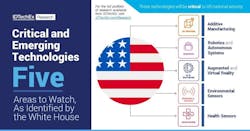White House IDs additive manufacturing as one of five technology areas to watch
WASHINGTON - In February 2022, the White House issued an updated list of critical and emerging technologies that the Office of Science and Technology Policy (OSTP), National Science and Technology Council (NSTC), and National Security Council (NSC) have identified as being important for U.S. national security. Numerous technology areas have been featured, including advanced manufacturing, hypersonics, biotechnologies and artificial intelligence. Of these, IDTechEx has highlighted which areas to watch and why exactly the White House has shortlisted them as critical technologies, AviationPros report.
Continue reading original article.The Military & Aerospace Electronics take:
24 Feb. 2022 - Additive manufacturing's (AM's) ability to manufacture complex objects with short lead times is quite appealing for defense applications, leading to significant interest and applied research from the U.S. military in the past decade. One public example of the U.S. military's 3D printing exploration is their projects with concrete 3D printing. When the military needs to assemble structures like barracks or hospitals quickly in combat zones or disaster areas, on-site concrete 3D printing offers the opportunity to quickly create those buildings. In 2018, the U.S. Marine Corps printed a concrete barracks in 40 hours, the first completely on-site continuous concrete print in the world. In 2021, the U.S. Army Corps of Engineers announced their Automated Construction of Expeditionary Structures (ACES) program, which will supply concrete 3D printers that can be deployed in difficult terrain.
Augmented and virtual reality (AR/VR) originally were largely developed from the defense industry. However, as application focus has moved toward enterprise and consumer markets, the adaptation of these off-the-shelf products for military use cases is a growing trend. For use of VR in training, this process appears relatively smooth: Lockheed Martin is reportedly using Varjo VR headsets for pilot instruction and Street Smarts VR uses the HTC Vive for training police and ground troops.
Critical subfields identified by the White House include "Advanced and Networked Sensing and Signature Management," "Quantum Information" and "Space Technologies and Systems." Sensors are essential components for these areas and numerous essential industries like healthcare, security and the environment. Across all these distinct fields, there is a common need for larger sensor arrays and more expansive networks.
Related: DARPA tasks Northrop Grumman with developing prototype AI assistant for rotorcraft
Jamie Whitney, Associate Editor
Intelligent Aerospace
